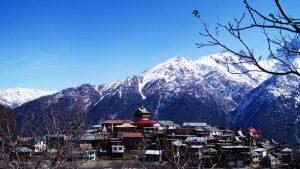Most of the world’s greatest Buddhist temples are situated in India, a nation that has a rich spiritual legacy. For people looking for peace and awakening, India’s Buddhist temples offer a fascinating trip across the rich tapestry of religious and cultural heritage. Holy sites across the nations, these locations are vibrant hubs for knowledge, prayer and centuries-old traditions, along with being beautiful pieces of architecture.
A profound feeling of peace and understanding is offered for those who seek it out at this Buddhist shrine, which additionally serves as a place of worship. Each sacred place ranging from the starting ancient ruin of Bihar to the serene to the peaceful landscape of Himachal Pradesh, narrates a unique story of its architectural beauty and dedication. It is a personal peek into the principle of Buddhism and the extensive variety of culture of India which comes from observing these sacred locations and serves as a journey through time.
Here are top 10 Buddhist temples to visit in India including the monasteries: –
- Mahabodhi Temple Bihar
- Mahaparinirvana Temple UP
- Namgyal Monastery Himachal
- Tawang Monastery Arunachal
- Tabo Monastery, Himachal Pradesh
- Rumtek Monastery, Sikkim
- Wat Thai Temple, Kushinagar UP
- Hemis Monastery Ladakh
- Ghoom Monastery, Darjeeling
- Spituk Monastery Ladakh
Also Check Out: Popular Buddhist Tour Packages
Mahabodhi Temple Bihar

Rising as an immense icon of Buddhism, the Mahabodhi Temple is a popular Buddha temple in India symbolizes precisely the spot where around 2,500 years ago Siddhartha Gautama attained awakening and become the Buddha. This UNESCO World Heritage site, that is is located in Bodh Gaya, which is one of the most prestigious destinations of pilgrimage for Buddhists worldwide. The earliest shrine was established at this spot in the 3rd century BCE by Emporer Ashoka, who eventually switched to Buddhism. Constructed in the 5th and 6th century CE, the present-day building is an outstanding example of medieval Indian brick architecture, featuring a rising pyramidal tower of 55 metres.
The temple complex is a serene heaven, surrounded by finely designed gardens and multiple smaller statues and stupas, each telling a story of devotion and dedication. Located at the centre of the complex is the famous Bodhi Tree, which has been an ancestor of the original tree where the Lord Buddha used to meditate. A trip to Mahabodhi temple blends religious study with cultural and historical learning.
Mahaparinirvana Temple UP

A significant Buddhist pilgrimage site, the Mahaparinirvana temple is located in Kushinagar, Uttar Pradesh. This temple is believed to be the place where Siddhartha Gautam, Buddha, attained Mahaparinirvana, or final freedom, around 482 BCE. This sacred place is renowned for being linked to the death of the Buddha and his eventual passage into Nirvana. Among the most famous iconic images of the Buddha in his final moments is a huge lying Buddha statue which resides in the complex of the Temple. This statue, measuring around 20 feet long, shows the Buddha sitting comfortably on his right side, symbolizing his freedom from the cycle of birth and rebirth.
Focusing on historical and spiritual studies, the building of the temple reflects the extensive legacy of Buddhist art. The Rambhar Stupa, which is believed to have been the site of Buddha’s the process of cremation, is just one of the many stupas and monasteries that encircle the main shrine. Writings and artecrafts relating to the early Buddhist tradition may additionally be seen on this site and makes it a must visit Buddhist places in India.
Namgyal Monastery Himachal

The 14th Dalai Lama’s monastery, Namgyal Monastery serves as the largest and most significant centre of Tibetan Buddhism and is located in McLeod Ganj, Himachal Pradesh. The third Dalai Lama established the monastery in 1575, and when the Dalai Lama went into exile because of the Tibetan revolt in 1959, it was reconstructed in India. Situated in Dharamshala’s serene hills, the monastery is an important hub for Buddhist learning, preservation of culture, meditation and prayer. It maintains the traditions, teachings, and customs of Tibetan Buddhism in exile and functions as an emblem of Tibetan heritage as well as playing a religious role.
A vibrant establishment which is important to maintaining the Tibetan way of life is the Namgyal Monastery. The monastery’s monks learn Buddhist texts, prayer, meditation and rituals; some are receiving to support the Dalai lama and his spiritual work. The monastery, which is accessible for both civilians and monks, provides an idyllic environment for those looking to learn about Tibetan Buddhism to meditate in an atmosphere of peace.
Tawang Monastery Arunachal

Among India’s most religious and historical attractions is Tawang Monastery which is located in the northwest of the Indian state of Arunachal Pradesh. Located in the beautiful town of Tawang, at a height of 10,000 feet monastery is the greatest in India and the second largest worldwide, close to Potala Pala in Lhasa. This monastery is an important centre for the upholding and propagation of Tibetan Buddhist culture and was established by Merak Lama Lodre Gyatso in 1680-1681. It is also an element of the Gelupa branch of Tibetan Buddhism. Over 300 monks are living and learning Buddhism in this monastery, which acts as both a place of worship and a place of learning.
The monastery’s architecture is remarkable; due to its high walls and wide courtyards which resembles a fort. The main attraction of the three-story structure is a 28-foot tall golden sculpture of Lord Buddha, which is an imposing satisfying hall and library filled with ancient texts. The monastery’s beautiful vistas of the surrounding Himayalan hills are simply breathtaking.
Tabo Monastery, Himachal Pradesh

Among the oldest and most sacred Buddhist monasteries in India is Tabo Monastery, that is located in the remote Spiti Valley in Himachal Pradesh. Founded in 996AD by the Buddhist ruler Yeshe-O of the Guge family in the western Himalayas, Tabo monastery is popular Buddhist monasteries in India and famous for its immense spiritual importance, social and historical. The monastery is renowned for its historic which fuses Tibetan and Indian forms, and is often known as the “Ajanta of Himalayas”, due to its stunning paintings and paintings. Located on the valley stage, Tabo is bounded by the sharp, barren terrain which give off a mysterious, serene vibe in contrast to with several other monasteries placed on hilltop.
The nine temples, numerous stupas, and meditation chambers maintained by the monks form the entire structure if the monastery. The main temple, tsuglagkhang, is dedicated to magnificent sculpture, beautiful paintings on wall, and papers from history that have been maintained from more than a thousand years ago.
Rumtek Monastery, Sikkim

Famous for its importance in Tibetan Buddhism, Rumtek Monastery is located in India of Sikkim, a short drive from Gangtok. Located far from Tibet, it is the centre of Karma Kagyu custom, constructed in the sixteenth century by the ninth Karmapa. Tsurphu Monastery a replica of the real monastery in Tibet, is renowned for its beautiful building. Lush greenery surrounding it offers a calm environment for prayer and relaxation. A handful of monks reside in the monastery where they are involved in daily prayers, teaching and rites. The sixteenth Karmapa’s remains are kept in the Golden Stupa, a renowned attraction attracting pilgrims and tourists from all over the world.
Additionally, Rumtek is a host to a variety of religious events. One of the busiest among them is the Tibetan New Year, which is celebrated with celebrations and mask dances. For tourists who are interested in finding out more about Sikkim’s rich Buddhist history, this is a must-visit location due to its peaceful environment, significance in history and exciting new cultural activities.
Wat Thai Temple, Kushinagar UP

The renowned Buddhist temple Wat Thai Temple, which is located in Khushinagar, Uttar Pradesh displays Thai architectural and cultural characteristics. Built during the 1990s in honour of the visit of the Thai King to Khushinagar, the temple is a popular Buddhist temple in India and serves as evidence of the deep and strong of cultural and spiritual ties which exist between India and Thailand. Because it is believed to be the spot where Lord Buddha got Mahaparinirvana or final awakening, Khushinagar itself is among the four sacred pilgrimage locations in Buddhism. With a golden spire, intricate carvings, and sculptures which represent the life and teachings of Buddhism, the temple’s design skillfully intrigues Thai and Indian architectural components.
Wat Thai Temple’s lovely surroundings offer visitors and worshippers an idyllic heaven. A vast meditation hall, lush green grounds, and a range of Buddhist sculptures create a serene ambience which is perfect for contemplation and prayer.
Hemis Monastery Ladakh

Among the biggest and renowned monasteries in India is Hemis Monastery is a top buddhist tourist places in India which is found in the remote and scenic Ladakh area. This 17th century Tibetan Buddhist monastery is linked with the Drukpa lineage, an established and prominent institution within Vijayrana Buddhism, and is located among the wild beauty of the Indus valley along with the rugged terrain. Hemis Monastery was built in 1672 by the initial state Satsang Rapsa Nawang Gyatso, with the backing of King Senggee Namgyal. It is extremely important from a historical, spiritual and cultural standpoint. Spacious prayer hall, beautifully painted walls, displaying the Buddhist deities and mandala, and a wide range of ancient texts, thangkas and statues highlights the remarkable architecture of the monastery.
The primary reason guests visit Hemis for the annual Hemis festival, a vibrant two-day celebration which takes place in June or July to celebrate the legacy of the famous Indian saint, Guru Padmasambhava, who has been linked with introducing Buddhism to Tibet. Visitors as well locals both come together to celebrate this festival in the Hemis monastery in large number.
Ghoom Monastery, Darjeeling

In Darjeeling, West Bengal, Ghoom Monastery, also known as Yiga Choeling, Monaster, serves as one of the most renowned and historic Tibetan Buddhist monasteries. Positioned around 7,500 feet above the sea level, this spot offers stunning views and an idyllic setting over the backdrop of the majestic Himalayan range. Founded by the Mongolian monk Lama Sherab Gytso in 1850, Ghoom monastery has associated of the Dalai Lama’s school of Tibetan Buddhism, recognized as the Gelupa “Yellow Het” sect. The statue of Maitreya Buddha, the Buddha of the future, towering at an elevation of 15 feet and beautifully decorated with precious stone and clothes, is the monastery’s most prominent landmark.
Traditional Tibetan paintings, thangkas which represent different aspects of Buddhist mythology and principles, grace the walls of the monastery. The monks reside there here contribute to the divine energy that surrounds the monastery via their regular prayers, meditation, and rituals.
Spituk Monastery Ladakh

In Ladakh, India, Spituk Monastery additionally referred to as Spituk Gompa, is also renowned as a Buddhist monastery located near Leh. Formerly belonged to the Kadampa school of Tibetan Buddhism, the monastery eventually was taken over by the Gelugpa order. It was established in the 11th century by Od-de, who was the brother of Lha Lama Changchub Od. Spituk, situated atop a hill, offers magnificent views across the surrounding harsh landscape and the Indus river. The monastery is famous for its ancient thangkas, powerful representation and sculptures of Mahakal, a fierce deity worshipped during the January Gustor Festival.
Additionally, to housing over 100 monks, the monastery offers a small exhibition with historical masks, weapons, and sacred items on display. For guests who love experiencing Ladakh’s rich heritage of culture, a trip to Spituk monastery is a necessity due to its amazing setting, cultural significance, and deep religious value.
Top 10 Buddhist places and monasteries in India comes with an extensive number of monasteries and temples that are remarkable for their mystical, importance, historical and architectural values, India is a home to a unique complex tapestry of Buddhist history. A unique window into the activities and teachings of the Buddha can possibly be found at each spot, starting with the Mahabodhi temple to the ancient Spituk monastery with their magnificent artworks. The ancient significance might be felt in the sites like Khushinagar and Sarnath, and temples like Tawang and Hemis blend religious faith with breathtaking scenery.
About the author
Having an experience of more than 16 yrs in the Himalayas, Arun is the main driving force & mentor at the Peak Adventure Tours, a leading adventure travel agency in India offers trekking tours in Indian Himalayas including Nepal, Bhutan & Tibet. A long history with exceptional experiences he is the “Marathon Man” in the field of adventure. Today Arun looks after the Peak Adventure and shapes & designs the venture of the organization. He is contributing to this blog as a regular guest author.

 +91-9212777225
+91-9212777225 Plan Your trip
Plan Your trip

































